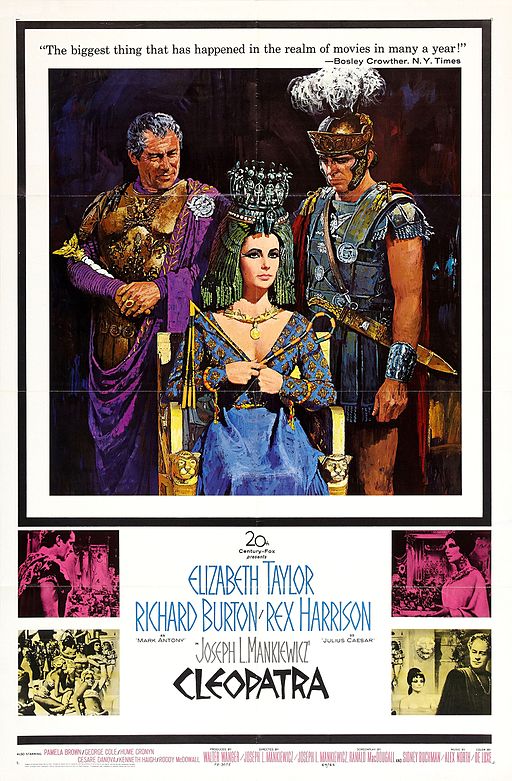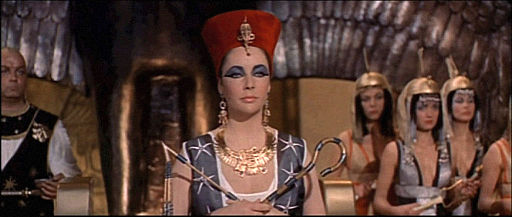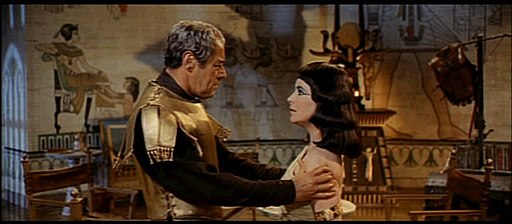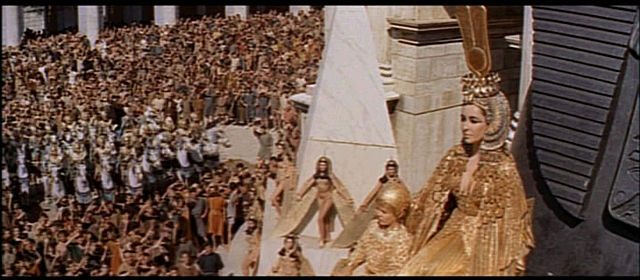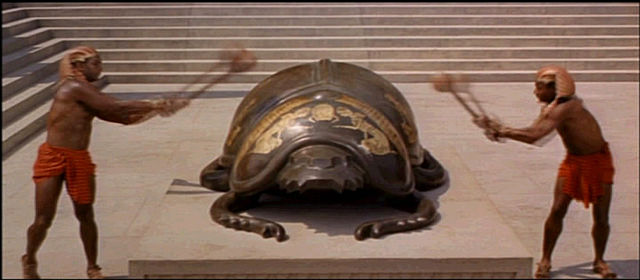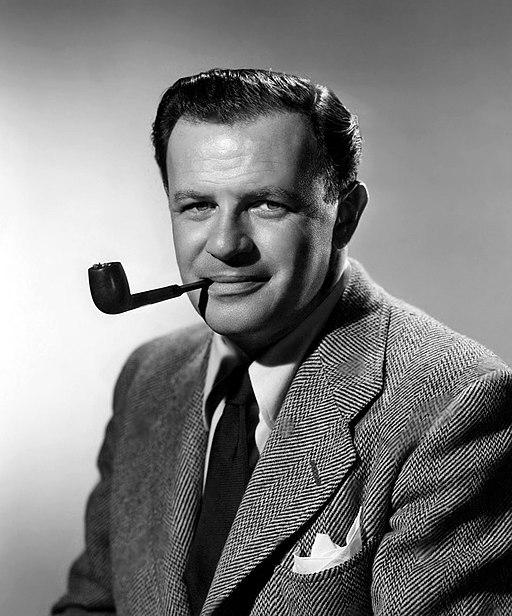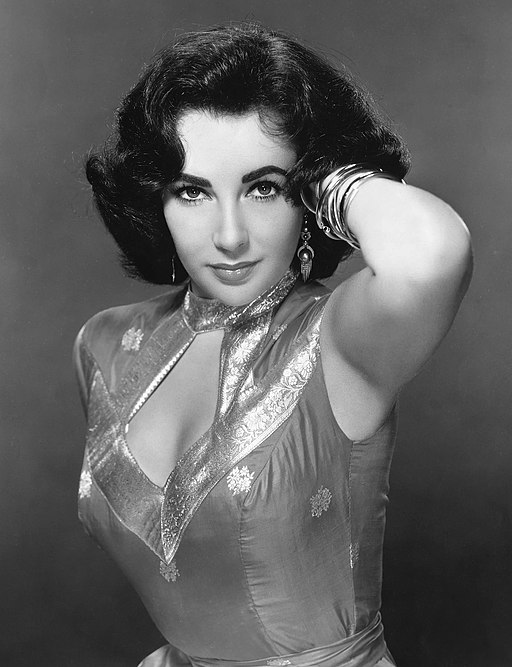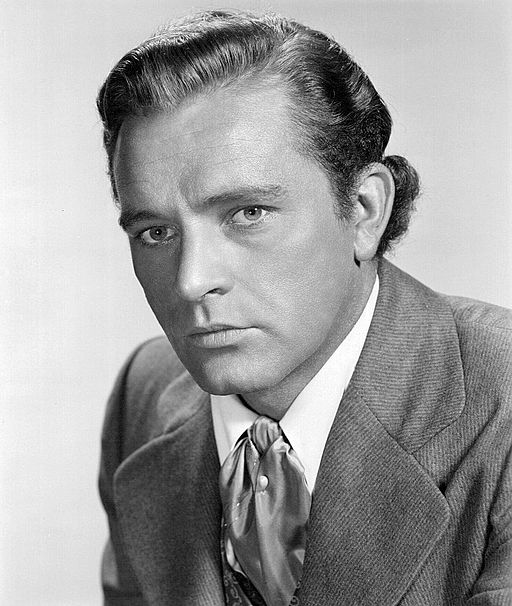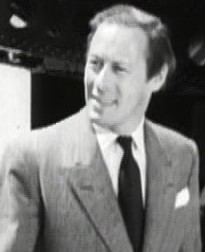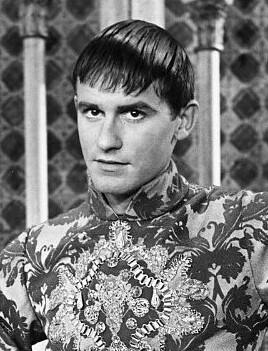Cleopatra - 1963
back| Released by | 20th Century Fox |
| Director | Joseph L. Mankiewicz |
| Producer | Walter Wanger |
| Script | Joseph L. Mankiewicz - Ranald MacDougall - Sidney Buchman |
| Cinematography | Leon Shamroy |
| Music by | Alex North |
| Running time | 192 minutes |
| Film budget | $31.1 million |
| Box office sales | $57.7 million |
| Main cast | Elizabeth Taylor - Richard Burton - Rex Harrison - Roddy McDowall - Martin Landau |
Cleopatra
An Epic Tale of Love, Power, and Tragedy
"Cleopatra" (1963) is an epic historical drama directed by Joseph L. Mankiewicz, starring Elizabeth Taylor as Cleopatra, Richard Burton as Mark Antony, and Rex Harrison as Julius Caesar.
The film chronicles Cleopatra's alliances and romantic entanglements with Caesar and Antony, her political maneuvers, and eventual downfall. Known for its lavish sets, extravagant costumes, and dramatic performances, the film's production faced numerous challenges, resulting in a significant budget overrun.
Despite mixed initial reviews, "Cleopatra" won four Academy Awards and became notable for its cultural and cinematic impact.
Related
Cleopatra – 1963
Summary, Cast and Analysis
"Cleopatra" is an epic historical drama that chronicles the life of Cleopatra VII, the last active ruler of the Ptolemaic Kingdom of Egypt. The film is notable for its grandeur, elaborate sets, and the iconic performance by Elizabeth Taylor as Cleopatra.
Part 1: Rise to Power
The story begins with Cleopatra's (Elizabeth Taylor) initial involvement with Julius Caesar (Rex Harrison). After the death of her father, Cleopatra is forced into exile by her brother Ptolemy XIII. Seeking to reclaim her throne, Cleopatra cleverly wraps herself in a rug and is smuggled into the palace where she meets Caesar. Impressed by her intelligence and charm, Caesar helps her overthrow her brother, and Cleopatra becomes the sole ruler of Egypt. She also becomes Caesar's lover, and they have a son, Caesarion.
Part 2: Political Maneuvering and Love
Cleopatra travels to Rome with Caesar, creating a scandal due to their open affair. Despite the Roman Senate's disapproval, Caesar continues his relationship with Cleopatra and prepares for their son's future. However, Caesar's ambition and disregard for Roman traditions lead to his assassination. Cleopatra, fearing for her safety, returns to Egypt.
Part 3: Alliance with Mark Antony
Following Caesar's death, Rome is plunged into chaos, leading to the rise of the Second Triumvirate, including Mark Antony (Richard Burton), Octavian (Roddy McDowall), and Lepidus. Cleopatra strategically aligns herself with Antony, who is captivated by her beauty and political acumen. Their romance blossoms, and Antony neglects his duties in Rome, much to the chagrin of Octavian. Antony and Cleopatra's relationship grows deeper, and they marry, causing a rift with Rome.
Part 4: Downfall and Tragedy
Tensions between Antony and Octavian culminate in the Battle of Actium, where Antony's forces are decisively defeated. Fleeing back to Egypt, Antony and Cleopatra face the inevitable. As Octavian's forces close in, Antony, believing Cleopatra to be dead, falls on his sword. Cleopatra, determined to avoid capture and humiliation, arranges a grand mausoleum for herself. She commits suicide by allowing an asp to bite her, ensuring her legacy remains untarnished.
Analysis:
Historical Context and Accuracy:
The film takes certain liberties with historical accuracy for dramatic effect. While the central events are based on real historical occurrences, the portrayal of characters and relationships often leans towards melodrama. For instance, Cleopatra's manipulation of Caesar and Antony, while historically documented, is exaggerated to highlight her cunning and allure.
Themes and Motifs:
- Power and Ambition: The film explores the dynamics of power and ambition, focusing on Cleopatra's relentless pursuit of maintaining her throne and influence. Her relationships with Caesar and Antony are depicted as strategic alliances aimed at securing her and Egypt's future.
- Love and Betrayal: At its core, "Cleopatra" is also a tragic love story. The romantic entanglements between Cleopatra and her Roman lovers are depicted with intense passion, underscored by eventual betrayal and disillusionment. This duality adds depth to Cleopatra's character, showing her vulnerability and strength.
- Cultural Clash: The film highlights the cultural differences between Rome and Egypt. Cleopatra's opulent lifestyle and Egyptian customs starkly contrast with Roman austerity, symbolizing the broader clash between the two civilizations.
Cinematic Techniques:
- Production Design: The film is renowned for its lavish production design, featuring grandiose sets and elaborate costumes that convey the opulence of ancient Egypt. The attention to detail in set pieces, such as Cleopatra's entrance into Rome, underscores the film's epic scale.
- Cinematography: Leon Shamroy's cinematography captures the grandeur and intimacy of the narrative. The use of wide shots to depict the scale of battles and intricate close-ups during personal moments adds a dynamic visual texture.
- Performance: Elizabeth Taylor's portrayal of Cleopatra is both commanding and nuanced. Her chemistry with Richard Burton's Mark Antony adds a layer of authenticity to their tumultuous relationship. Rex Harrison's Julius Caesar provides a strong counterpoint, embodying Roman discipline and ambition.
Impact and Legacy:
Despite its troubled production history and budget overruns, "Cleopatra" remains a significant film in Hollywood history. Its lavish production and star-studded cast made it a cultural milestone. While it faced mixed reviews upon release, over time, the film has been reassessed and appreciated for its artistic ambition and Elizabeth Taylor's iconic performance.
In conclusion, "Cleopatra" is a film that combines historical drama, romance, and epic spectacle. It provides a cinematic portrayal of one of history's most fascinating figures, showcasing her intelligence, ambition, and tragic end. Through its grand narrative and visual splendor, the film continues to captivate audiences, solidifying its place in the annals of classic cinema.
Classic Trailer from Cleopatra:
Full Cast:
- Elizabeth Taylor as Cleopatra VII
- Richard Burton as Mark Antony
- Rex Harrison as Julius Caesar
- Roddy McDowall as Octavian
- Martin Landau as Rufio
- Hume Cronyn as Sosigenes
- George Cole as Flavius
- Kenneth Haigh as Brutus
- Andrew Keir as Agrippa
- Richard O'Sullivan as Ptolemy XIII
- Pamela Brown as High Priestess
- Cesare Danova as Apollodorus
- Dameon Vick as Eros
- Robert Stephens as Germanicus
- Francesca Annis as Eiras
- Grégoire Aslan as Pothinus
- John Doucette as Achillas
- Andrew Faulds as Canidius
- Herbert Berghof as Theodotus
- Michael Gwynn as Claudius
- Andrew Leigh as Casca
- Martin Benson as Ramos
- Carlo D'Angelo as Phoebus
- Jean Marsh as Octavia
- John Cairney as Phoebus
Analysis of the Direction of Joseph L. Mankiewicz:
Joseph L. Mankiewicz approached "Cleopatra" with a grand vision, aiming to create an epic that would capture the grandeur and complexity of the historical period. His ambition was evident in the film's scale, from the intricate set designs to the expansive battle scenes. Mankiewicz sought to balance historical authenticity with dramatic storytelling, crafting a narrative that was both visually spectacular and emotionally resonant.
Character Focus:
Mankiewicz, known for his ability to develop rich, multifaceted characters, brought this strength to "Cleopatra." His direction focused on exploring the intricate personalities and motivations of the central figures, particularly Cleopatra, Julius Caesar, and Mark Antony. Mankiewicz portrayed Cleopatra not merely as a seductress but as a shrewd, intelligent, and powerful leader. This character depth allowed audiences to engage more profoundly with the historical figures, understanding their ambitions, fears, and desires.
Balancing Spectacle and Intimacy:
One of Mankiewicz's notable achievements in "Cleopatra" was his ability to balance grand spectacle with intimate moments. The film is filled with lavish sequences, such as Cleopatra's entrance into Rome and the epic Battle of Actium. However, Mankiewicz also excelled in quieter, character-driven scenes that delved into the personal dynamics between Cleopatra and her Roman lovers. This balance ensured that the film was not only a visual feast but also a compelling human drama.
Dialogue and Screenplay:
As both director and co-writer, Mankiewicz infused the screenplay with sharp, eloquent dialogue that reflected the intelligence and wit of the characters. His background in writing enabled him to craft conversations that revealed much about the characters' inner lives and political maneuverings. This emphasis on dialogue elevated the film above mere spectacle, adding layers of meaning and tension to the interactions.
Use of Cinematography:
Collaborating with cinematographer Leon Shamroy, Mankiewicz utilized sweeping camera movements and grandiose compositions to capture the epic scale of ancient Egypt and Rome. The cinematography in "Cleopatra" is marked by its rich color palette and meticulous framing, which enhance the film's opulent aesthetic. Mankiewicz's direction ensured that the visual elements complemented the narrative, creating a cohesive and immersive experience.
Handling Production Challenges:
The production of "Cleopatra" was notoriously troubled, plagued by delays, budget overruns, and changes in cast and crew. Despite these challenges, Mankiewicz managed to deliver a coherent and visually stunning film. His perseverance and ability to adapt under pressure were crucial in bringing the ambitious project to completion. Mankiewicz's direction under such difficult circumstances demonstrated his resilience and commitment to the film.
Performance Direction:
Mankiewicz drew remarkable performances from his cast, particularly Elizabeth Taylor, Richard Burton, and Rex Harrison. His direction emphasized the emotional depth and complexity of their relationships, making their interactions feel authentic and compelling. Mankiewicz's ability to guide his actors to deliver nuanced performances was instrumental in grounding the film's larger-than-life narrative in human emotion.
Legacy and Impact:
While "Cleopatra" faced mixed reviews upon its release and was criticized for its length and pacing, Mankiewicz's direction has been reassessed over time. The film is now appreciated for its artistic ambition and the sheer scope of its production. Mankiewicz's direction played a significant role in creating one of the most visually and narratively ambitious films of its time, leaving a lasting impact on the genre of historical epics.
In conclusion, Joseph L. Mankiewicz's direction of "Cleopatra" showcased his ability to blend spectacle with intimate character study, manage a complex and troubled production, and draw powerful performances from his cast. His vision and execution made "Cleopatra" a memorable cinematic experience, highlighting his skills as a storyteller and filmmaker.
Commanding Performance of Elizabeth Taylor:
Elizabeth Taylor's portrayal of Cleopatra is marked by a commanding and magnetic presence that captures the essence of the legendary Egyptian queen. From her first appearance on screen, Taylor exudes confidence and authority, embodying Cleopatra's regal nature. Her physical beauty and charismatic aura make her a believable and compelling ruler, capable of captivating both Julius Caesar and Mark Antony, as well as the audience.
Emotional Depth:
Taylor's performance goes beyond surface-level charm, delving into the emotional complexities of Cleopatra's character. She skillfully navigates the queen's multifaceted personality, portraying her as both a shrewd political strategist and a vulnerable woman deeply affected by her personal relationships. Taylor's ability to convey Cleopatra's inner turmoil, especially in moments of personal loss and political defeat, adds a layer of depth to the character.
Chemistry with Co-Stars:
One of the standout aspects of Taylor's performance is her palpable chemistry with her co-stars, particularly Richard Burton (Mark Antony) and Rex Harrison (Julius Caesar). Her scenes with Harrison are marked by a playful yet strategic interaction, reflecting Cleopatra's initial seduction and political maneuvering. In contrast, her relationship with Burton's Antony is characterized by intense passion and volatility, highlighting the deep emotional connection and eventual tragedy of their union. Taylor's ability to adapt her performance to these differing dynamics showcases her versatility as an actress.
Vocal Performance:
Taylor's use of voice in the film is particularly notable. She employs a measured and often hushed tone, imbuing her lines with a sense of calculated intent. Her dialogue delivery is both precise and evocative, enhancing the dramatic weight of her speeches. Taylor's vocal control helps convey Cleopatra's intelligence and manipulative prowess, as well as her moments of tenderness and vulnerability.
Physicality and Costume:
Taylor's physical performance is also a key element of her portrayal. She uses her body language to express Cleopatra's confidence and authority, often adopting a poised and statuesque demeanor. The film's elaborate costumes and makeup further accentuate her portrayal, allowing her to inhabit the role fully. Taylor's ability to wear the opulent costumes with grace and authenticity adds to the visual and dramatic impact of her performance.
Transformation and Range:
Throughout the film, Taylor's performance evolves to reflect Cleopatra's journey from a young queen fighting for her throne to a seasoned ruler facing the decline of her power. She adeptly captures this transformation, portraying Cleopatra's increasing weariness and desperation as her fortunes change. Taylor's range is evident in scenes that require her to shift from seductive charm to fierce determination, and from regal composure to heartfelt despair.
Iconic Moments:
Taylor's performance is punctuated by several iconic moments that have become synonymous with her portrayal of Cleopatra. One such scene is Cleopatra's grand entrance into Rome, where Taylor's presence and the film's extravagant production come together to create a memorable cinematic spectacle. Another is her final scene, where Cleopatra, faced with the inevitability of her defeat, chooses to end her life with dignity. Taylor's nuanced and powerful delivery in these scenes cements her status as the definitive Cleopatra.
Legacy:
Elizabeth Taylor's portrayal of Cleopatra is often regarded as one of the defining performances of her career. Despite the film's initial mixed reception, her performance has been praised for its depth, complexity, and star power. Taylor's Cleopatra remains a cultural touchstone, influencing subsequent portrayals of the character in film and television. Her ability to bring humanity and gravitas to such a larger-than-life figure is a testament to her talent and dedication as an actress.
In conclusion, Elizabeth Taylor's performance in "Cleopatra" is a masterclass in embodying a historical figure with both grandeur and subtlety. Her commanding presence, emotional depth, and ability to convey the complexities of Cleopatra's character make her portrayal both iconic and enduring. Taylor's performance is a central pillar of the film's lasting legacy, showcasing her exceptional skills as one of Hollywood's greatest actresses.
Notable Film Lines from Cleopatra:
Cleopatra (Elizabeth Taylor):
"How dare you and the rest of your barbarians set fire to my library! Play conqueror all you want, Mighty Caesar! Rape, murder, pillage thousands, millions of human beings! But neither you nor any other barbarian has the right to destroy one human thought!"
Julius Caesar (Rex Harrison):
"I love the name of honor, more than I fear death."
Cleopatra (Elizabeth Taylor):
"I will not be triumphed over."
Mark Antony (Richard Burton):
"I found Rome a city of bricks and left it a city of marble."
Cleopatra (Elizabeth Taylor):
"The way to prevent war is to be ready for it."
Julius Caesar (Rex Harrison):
"I came, I saw, I conquered."
Cleopatra (Elizabeth Taylor):
"You will kneel. I am Egypt. Egypt kneels to no one."
Mark Antony (Richard Burton):
"If you knew, O Cleopatra, how little your name meant to me."
Cleopatra (Elizabeth Taylor):
"Without you, I have nothing. Nothing!"
Octavian (Roddy McDowall):
"The time has come when I can no longer stand idly by and watch Rome fall to pieces."
Awards and Recognition for the Movie:
Academy Awards (Oscars) 1964:
Won:
Best Art Direction-Set Decoration, Color:
John DeCuir, Jack Martin Smith, Hilyard M. Brown, Herman A. Blumenthal, Walter M. Scott, Paul S. Fox
Best Cinematography, Color:
Leon Shamroy
Best Costume Design, Color:
Irene Sharaff, Vittorio Nino Novarese, Renie
Best Effects, Special Visual Effects:
Emil Kosa Jr.
Nominated:
Best Picture:
Walter Wanger
Best Actor in a Leading Role:
Rex Harrison
Best Film Editing:
Dorothy Spencer
Best Music, Score - Substantially Original:
Alex North
Best Sound:
James Corcoran, 20th Century-Fox Studio Sound Department
Golden Globe Awards 1964:
Nominated:
Best Motion Picture – Drama
Best Director – Motion Picture:
Joseph L. Mankiewicz
Best Actress in a Motion Picture – Drama:
Elizabeth Taylor
Best Actor in a Motion Picture – Drama:
Rex Harrison
Best Supporting Actor – Motion Picture:
Roddy McDowall
BAFTA Awards 1964:
Nominated:
Best British Actor:
Richard Burton
Directors Guild of America (DGA) Awards 1964:
Nominated:
Outstanding Directorial Achievement in Motion Pictures:
Joseph L. Mankiewicz
Classic Scenes from “Cleopatra”:
Cleopatra’s Entrance into Rome:
Description: One of the most iconic scenes in the film is Cleopatra’s grand entrance into Rome. Cleopatra (Elizabeth Taylor) arrives on a massive golden sphinx, surrounded by an elaborate procession of dancers, soldiers, and exotic animals. The spectacle is designed to impress and overwhelm the Roman populace and leaders, showcasing Cleopatra’s power and wealth.
Significance: This scene epitomizes the film’s lavish production values and Elizabeth Taylor’s star power. It highlights Cleopatra’s strategic use of pageantry and opulence to assert her dominance and influence over Rome. The meticulous set design and elaborate costumes emphasize the film's epic scale and attention to detail.
Julius Caesar and Cleopatra’s First Meeting:
Description: Cleopatra’s first meeting with Julius Caesar (Rex Harrison) is another pivotal moment. Cleopatra is rolled into Caesar’s chambers hidden inside a rug, which is then unrolled to reveal her. This bold and unconventional entrance captures Caesar’s attention and sets the stage for their alliance and romance.
Significance: This scene underscores Cleopatra’s intelligence and cunning, portraying her as a master of political and personal strategy. It also marks the beginning of her relationship with Caesar, which significantly impacts the course of events in the film. Elizabeth Taylor’s performance in this scene is both seductive and commanding, establishing Cleopatra as a formidable and charismatic leader.
The Death of Julius Caesar:
Description: The assassination of Julius Caesar is a crucial turning point in the film. In a tense and dramatic sequence, Caesar is surrounded and stabbed by the Roman senators, including his trusted friend Brutus (Kenneth Haigh). Cleopatra’s reaction to the news of Caesar’s death is one of shock and devastation.
Significance: This scene is important for its historical significance and emotional impact. It marks the end of Cleopatra’s alliance with Caesar and sets the stage for her subsequent relationship with Mark Antony. The scene is well-executed, with effective use of suspense and dramatic pacing, highlighting the betrayal and chaos that follows Caesar’s death.
The Battle of Actium:
Description: The Battle of Actium is one of the film’s most ambitious and action-packed sequences. This naval battle between the forces of Mark Antony (Richard Burton) and Octavian (Roddy McDowall) is depicted with grand scale and intensity. Cleopatra’s fleet is involved, and the battle ultimately leads to Antony’s defeat.
Significance: This scene demonstrates the film’s technical prowess and ability to stage large-scale action scenes. It is a turning point that leads to the downfall of Antony and Cleopatra, showcasing the futility of their resistance against Octavian. The battle’s choreography and special effects are noteworthy, contributing to the epic feel of the film.
Cleopatra’s Death:
Description: The film’s climax is the poignant and tragic death of Cleopatra. After Antony’s suicide, Cleopatra chooses to end her life rather than be paraded as a trophy in Octavian’s triumph. She arranges to be bitten by an asp, delivering a soliloquy as she succumbs to the venom.
Significance: Cleopatra’s death scene is one of Elizabeth Taylor’s most powerful moments in the film. Her performance captures Cleopatra’s dignity, resolve, and ultimate defiance in the face of defeat. The scene is emotionally charged and visually striking, with Taylor’s portrayal leaving a lasting impression on the audience. It encapsulates the film’s themes of love, power, and tragic fate.
Antony’s Final Moments:
Description: Before Cleopatra’s death, Mark Antony’s final moments are also deeply moving. Believing Cleopatra to be dead, Antony falls on his sword. He is brought to Cleopatra, and they share a tender and heart-wrenching farewell before he dies in her arms.
Significance: This scene highlights the intense and tragic love between Antony and Cleopatra. Richard Burton’s and Elizabeth Taylor’s chemistry is palpable, and their performances convey the deep emotional bond between their characters. The scene is a culmination of their tumultuous relationship and underscores the personal cost of their political ambitions.

